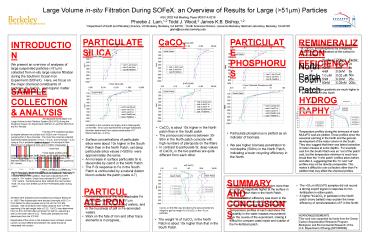SAMPLE COLLECTION PowerPoint PPT Presentation
1 / 1
Title: SAMPLE COLLECTION
1
Large Volume in-situ Filtration During SOFeX an
Overview of Results for Large (gt51mm) Particles
AGU 2002 Fall Meeting. Paper OS11A-0218 Phoebe
J. Lam,1,2 Todd J. Wood,2 James K.B. Bishop,1,2 1
Department of Earth and Planetary Science, UC
Berkeley, Berkeley, CA 94720 2 Earth Sciences
Division, Lawrence Berkeley National Laboratory,
Berkeley, CA 94720 pjlam_at_socrates.berkeley.edu
PARTICULATE SILICA
CaCO3
PARTICULATE PHOSPHORUS
REMINERALIZATION EFFICIENCY
INTRODUCTION We present an overview of analyses
of large suspended particles (gt51mm) collected
from in-situ large volume filtration during the
Southern Ocean Iron Experiment (SOFeX). Here, we
focus on the major chemical constituents of
particles Si, CaCO3, and organic matter
(particulate phosphorus).
- We can examine remineralization of particulate
Si, CaCO3, and phosphorus by comparing
approximate concentrations at the surface to
those at 200m
SAMPLE COLLECTION ANALYSIS We deployed the
Multiple Unit Large Volume in-situ Filtration
System (MULVFS) during the Southern Ocean Iron
Experiment (SOFeX) in Jan/Feb 2002 from the R/V
Revelle. The MULVFS collected samples at
depths between the surface and 1000m over 4 hours
of pumping from 3 flow channels. The main flow
channel collected size-fractionated particles
(gt51mm, 1-51mm, and nominally lt1mm) using a 51mm
polyester mesh and a pair of microquartz fiber
filters (1mm) in sequence from up to 12,000L of
seawater. Three depth profiles were
collected in the Si-poor North Patch, and 5 depth
profiles were collected in the Si-rich South
Patch, inside and outside of Fe-fertilized waters
(Fig.1). The location of the casts were guided by
SF6 values. Here, we focus on preliminary
results from bulk chemical analyses of particles
collected from the gt 51mm size fraction.
- The concentration gradients are much higher in
the South than in the North
HYDROGRAPHY
Variability in the numbers are largely due to
heterogenity on the filter. Error bars represent
the average standard deviation determined from
repeat subsamples of 17 filters (std.dev.3.91).
- CaCO3 is about 10x higher in the North patch than
in the South patch. - The pronounced maxima between 35-90m in the North
patch coincide with high numbers of pteropods on
the filters - In contrast to particulate Si, deep values of
CaCO3 in the two patches are quite different from
each other.
Temperature profiles during the downcast of each
MULVFS cast are plotted. These profiles show the
seasonal warming in the North and the general
development of the water column in the South.
They also suggest that there was lateral
advection of water masses at some depths. For
example, cast 6 in the South Patch was an out of
the patch cast, but the temperature minimum is
much less broad than the in the patch profiles
taken before and after it, suggesting that the
in and out profiles may not be directly
comparable. This makes it difficult to rule out
factors other than Fe addition that may affect
the chemical profiles.
- Particulate phosphorus is plotted as an indicator
of biomass. - We see higher biomass penetration to mid depths
(500m) in the North Patch, indicating a lower
recycling efficiency in the North.
- Surface concentrations of particulate silica were
about 10x higher in the South Patch than in the
North Patch, yet deep particulate silica values
(gt500m) were approximately the same. - An increase in surface particulate Si is
discernible by cast 8 in the North Patch. - The P-Si response to Fe in the South Patch is
confounded by a natural diatom bloom outside the
patch (casts 4-7)
Fig.1. Timeline of MULVFS casts and iron
additions. Red bars indicate times of iron
addition. Blue bars indicate MULVFS casts in
-Fe waters. Green bars indicate MULVFS casts in
Fe waters. Numbers above bars indicate the
cast number. Note we may have drifted out of the
Fe-fertilized patch during cast 2.
SUMMARY AND CONCLUSIONS
- The gt51mm MULVFS samples did not record a strong
export signal in response to iron fertilization
in either patch. - A higher CaCO3 in particles in the North patch
(more ballast) may explain the lower efficiency
of remineralization of P in the North.
- Biomass and particulate silica were more than an
order of magnitude higher at the surface in the
South Patch than in the North Patch. - Remineralization efficiency was lower in the
North Patch, as indicated by higher biomass
concentrations penetrating to mid-depths. - Temperature profiles of each cast show the
variability in the water masses encountered over
the course of the experiment, making it difficult
to compare casts inside and outside of the
Fe-fertilized patch.
PARTICULATE IRON
- Concentrations of 5 HCl leachable Fe were in the
tens of pM in gt51mm particles in non Fe-amended
waters, and in the hundreds of pM in Fe-amended
waters. - Work on the fate of iron and other trace elements
is in progress
All filters were prepared and processed
according to Bishop et al. 1985. Filter
subsamples were leached overnight at 60C in 0.5N
NaOH for silica analysis and in 5 HCl for ICP-MS
analysis. Salt corrections were made using Na
from ICP-MS, assuming a Nasalt weight ratio of
3.25. CaCO3 was determined from Ca from ICP-MS
after correction for salt Ca, assuming a salt
CaNa molar ratio of 0.02. Particulate
phosphorus was determined from the
ICP-MS. Magnitudes of the errors in the analyses
have not been worked out yet, so small
differences between the casts should be
interpreted with caution.
CaCO3 on the filter was divided by the
salt-corrected dry weight to get the weight of
CaCO3 in the gt51mm particles
ACKNOWLEDGEMENTS This work was supported by funds
from the Ocean Carbon Sequestration Research
Program, Biological, and Environmental Research
of the U.S. Department of Energy KP1202030.
- The weight of CaCO3 in the North Patch is about
10x higher than that in the South Patch.

